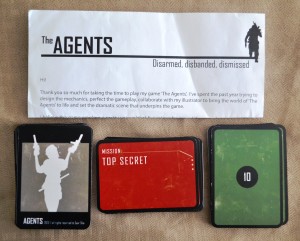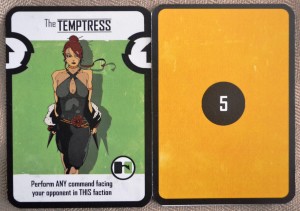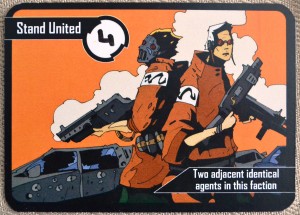“The Agents”, put simply, features more agents than an episode of “Get Smart”. It’s a tactical, turn-based card game that tasks players with earning the most victory points. As always, there’s a catch: cards have two different effects. You can play one of those effects on yourself, but the other effect will be made available to your opponent. It’s an interesting give-and-take mechanic that I don’t see very often in card games, but before I get into all of that, I’d like to thank Saar Shai for providing me with a free prototype copy. While the prototype may not fully represent the finished product, it is close enough to where I could do a full review. Be advised however that some of the rules mentioned below may be subject to change.
Components
There are four types of cards in this game:
Faction Agent Cards – Players will be using these cards to complete missions, earn victory points, and perform actions. All faction agent cards have a dual function, with the point portion pointing toward one player and the command portion facing the other player. These cards are played on the table next to each other in a horizontal line, between two players. Each player will have a “faction”, or row of cards, between them and the opponents on their left and right. The two player game is the exception, in that two horizontal rows of cards / factions will be between the players. The effects of these cards must be played immediately, though if performing the command is not possible, the card can still be played.
Free Agent Cards – These cards are similar to faction agent cards in that they have a dual function (points and command), but are a one-time use card and are thus discarded after being played. They are played between two players (off to the side) and the effects are carried out immediately. Unlike faction agent cards, free agent cards can only be played when performing the command on the card is possible.
Mission Cards – Mission cards allow players to score victory points and perform special actions. They are assigned (and played) on a player’s faction and remain in play until otherwise noted. Players are limited to two mission cards per faction, though their opponents are free to play up to two on their side of the faction row.
Point Cards – Point cards come in denominations of one, two, five, or ten. They are awarded to players throughout the game via the other three card types, when appropriate.
Setup & Gameplay
The faction and free agent cards are shuffled to form the agent deck and the mission cards are shuffled to form the mission deck. The point cards are organized by denomination and placed off to the side to form a “bank”. (The rules I received say to form a points deck, but I found the “bank” idea to be more efficient) Each player receives two agent cards, one mission card, and five victory points.
On a player’s turn, they will be able to perform TWO of the following actions:
1. Play Agent – The player can place an agent on any faction row between them and the player on their left or right. They turn the card appropriately, depending on whether they want to claim the command side or the point side of the card. The command must be played immediately, if possible. The number of agents a row can have is limited, depending on how many people are playing.
2. Reactivate Command – The player can play any command that is currently facing them.
3. Assign Mission – The player can place a mission card on their side of a faction row. Each player is limited to two mission cards per faction.
4. Switch / Retire Mission – The player can move a played mission card from one faction to the other, so as long as the “two mission card” rule isn’t being violated. Alternatively, they can discard a mission card from their hand or on the table and draw a new one from the deck, placing it into their hand.
5. Buy Agent / Mission – The player can spend one victory point to draw from the agent deck and three victory points to draw from the mission deck. Purchased cards are placed into the player’s hand and the point cards are returned to the bank. It’s worth noting that players can purchase the top card of the retirement pile from either deck (at extra cost), instead of drawing from the deck.
At the end of a player’s turn, they collect any points they’ve earned through mission and agent cards. When players manage to match point halves on the point side of faction agent cards, they score two points. Mission cards list their relative point value. These cards award points repeatedly over time as turns are completed. The first player to reach fifty points wins the game!

In this example, Vinnie would earn three points from the two adjacent dead agents (Bloodbath mission card). I, on the other hand, earned six…four from the mission and two from the completed set of half-arrows.
The above doesn’t cover all of the rules found in the manual, but should give you an idea as to how the game is played. For more information, you can check out the PDF manual here:
http://thoughtprocess.me/rulebook-agents/
The Review
First, I’d like to touch on the artwork and the quality of the cards. Dan Morison, the artist behind the cards, did a great job illustrating each agent’s unique character profile. I’m no expert in the arts, but the cards had a bit of a noir feel about them with a bit of “G.I. Joe” thrown in for good measure. The point cards were double-sided which could open up the door for cheating, though I’m told that this is unique to my printed copy. The copy I received also didn’t come with a box, so I can’t comment on the packaging portion. The PDF manual I received did a fairly good job in explaining the rules. Overall, I was pleased with the components and how easy it was to set up and clean up.
The learning curve on this game was moderate, in my opinion. It’s not that the game is a hard one to play, but there’s so much going on at once that new players may feel overwhelmed at first. You can try to learn as you go, but a lot of the mechanics work together and not understanding one concept might mess up your play session entirely. I found it best to teach others on how the cards work first before starting a game. Understanding how scoring ties in with mission and agent cards, as well as the limits of each card type, will greatly improve your first game.
As I mentioned in the beginning of this review, there’s a heavier focus on the give-and-take mechanic seeing as how agent cards have a dual function. This opens the door for quite a number of possibilities, seeing as how commands are different from card to card. Players will need to decide if they want to sacrifice commands for points in the hopes of Zerg-rushing their way to victory, avail themselves to more commands in the hopes of providing enough utility to control the board, or opt for a combination of the two. This strategy will change from game to game, depending on what agents and missions are drawn when.
Other strategic options take shape when you consider the costs associated with forming the factions in front of you. Buying an agent or a mission card costs victory points. Again, players will need to figure out how they’ll want to go about proceeding knowing this fact. You can purposely stunt your victory point growth to grow your empire (by purchasing cards), or you can keep your purchases to a minimum in the hopes of outdistancing your opponents in terms of points. Doing the latter however might cripple your growth later on since you’re not actively investing in missions and/or agents. For a quote unquote “simple card game”, there’s quite a bit to consider.
In playing with the kids, I noticed a big difference in playing with three players as opposed to two. In a two-player game, players have more control over the factions laid out before them and how cards affect the other player. In three-player plus game, you’ll have to balance your factions so as not to give any particular player a decisive advantage. If you see two of your buddies going at it pretty well, for example, you may want to see who was getting more points and try to balance things out with the factions YOU have control over. In essence, the more players you add, the less control a particular player ends up having.
To sum things up, “The Agents” is a unique, in-depth card game that will give your brain a workout. The dual functionality and variety of the cards themselves keeps things from getting repetitious. It may take a few playthroughs to full grasp the concepts and what all of the cards do, though this is common among a lot of card games that feature individual characters with unique abilities. Some of the concepts and strategies are a bit involved, so kids under the recommended age might not fare well. The early game isn’t so bad, but once you have a lot of cards on the table, it can be tough (even for me) to prevent sensory overload. Every child is different in terms of growth however, so parents will need to decide whether or not the game is suitable for their kids. Vinnie did fine after the “light bulb” went off and grasped how everything tied together.
At the time of writing (7/9/13), the game is seeking funding via a Kickstarter campaign (link below). With that said, is “The Agents” right for you? In my opinion, the game will not appeal to those who are easily intimidated or get frustrated easily by a lot of things going on at once. If you’re heavy into tactical card games however and don’t mind the chaos, then I recommend giving this one your attention.
Final Verdict: 7/10
—
You can learn more about and support this game by visiting the following websites:
http://www.kickstarter.com/projects/673576049/the-agents-a-double-edged-cards-game




